Pretty, isn’t it?

Take a step or two back.
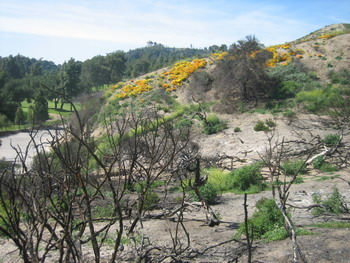
Griffith Park will need more than one Spring to recover from last year’s fire.
The scars are too deep.

Pretty, isn’t it?

Take a step or two back.

Griffith Park will need more than one Spring to recover from last year’s fire.
The scars are too deep.

„You see, the final result is going to stand on that hill a hundred years or more. Long after we are gone it will be pointed out as the Ennis House and pilgrimages will be made to it by lovers of the beautiful from everywhere.”
(Frank Lloyd Wright in a letter to Mr. & Mrs. Charles Ennis 1924)

Yes, pilgrimages are being made there. Ennis House, the largest of the four residential houses F L Wright built in the Los Angeles region, is beautiful and awe-inspiring by its sheer volume, sitting there on its ridge, overlooking the city below.

Thanks to the Ennis House Foundation, which came into being in 2005, the building will hopefully still be around once the “hundred years or more” mentioned above have passed. The ravages of time have not treated the building well; after the Northridge earthquake and water damage during the winter of 2005 the house was in danger of collapse. The worst damage to the façade, the foundation and the retaining wall has been repaired. Missing concrete blocks have been reproduced and replaced.

It will take many years to restore Ennis House to its full splendor and glory inside and out. But then even more lovers of the beautiful will come to see what F L Wright in 1924 was rightly so proud about.
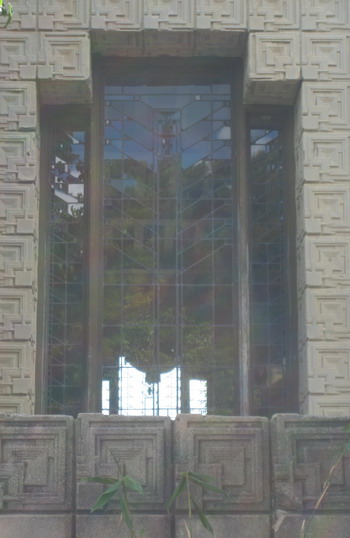
Corned Beef is virtually unknown in Germany, at least boiled with potatoes and cabbage in the proper Irish way. Corned Beef in Germany is generally understood to be something in a tin – bits of meat and fat and gelatin. Some people cut it into slices and eat it on bread. Others – like me – avoid it as the devil avoids holy water; or a vampire garlic; or a cat water. Unless it is a Turkish Van cat, they like to swim. Maybe they would even eat Corned Beef out of a tin. I wouldn’t. I also do not like to swim.
Anyway, every time I heard about Corned Beef & Cabbage in the US, I had a vision of this … stuff … out of a tin being cooked up. Not a very appetizing thought. On the other hand one does try to stay polite and tries to refrain from bursting out in a loud “but that is so, so, so utterly disgusting.”
Had I only burst out earlier. It took nearly a year for this misunderstanding to clear up, simply because nobody knew that I didn’t know. Then finally I learned that Corned Beef sans tin can be quite a lovely dish, when prepared properly, and is the perfect food for St. Patrick’s Day. Voila:

And the leftovers are just great on a sandwich.
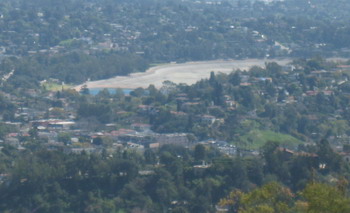
A rather rare sight – the temporarily drained Silver Lake Reservoir – reminded me once again how important water is to Los Angeles.
It is true that water is important to all regions and everyone, but Los Angeles could only become what it is today because of an engineering feat: The 233 m long Los Angeles Aqueduct, projected and overseen by William Mulholland (1855 – 1935).
Once the water came to the city, from 1913 on, the city started to grow at a fast pace. So fast, that Owens Lake, where the water came from, was completely drained by 1928. This fact led to the legendary Los Angeles Water Wars, upon which the movie “Chinatown” is based.
Mr. Mulholland continued on to find new sources for water to bring to the city. He was a highly esteemed and revered character, who once was even considered to become the mayor of Los Angeles. However, when asked whether he would run for office, he reportedly said: “I’d rather give birth to a porcupine backward.” Smart guy.
Sadly his career ended rather abruptly with the tragedy of the St. Francis Dam. After this catastrophe he lived the few remaining years of his life in self-imposed isolation.
Today Mulholland Drive and the fountain at the corner of Los Feliz Boulevard and Riverside serve as a reminder of the man who played a major part in shaping the city of Los Angeles.
One parking lot.
Three amusing license plates.
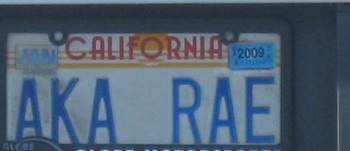
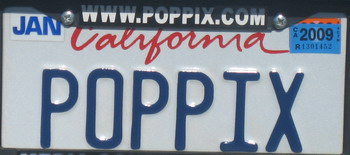
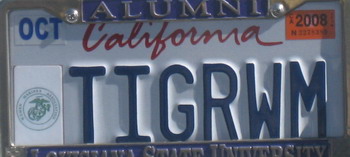
Squirrels eat fruit. That’s something I never knew.
Or is this only a very health-conscious SoCal squirrel?
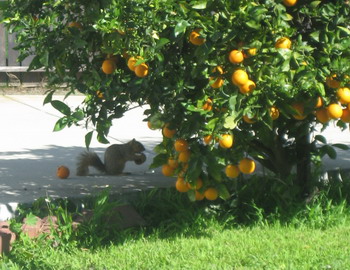
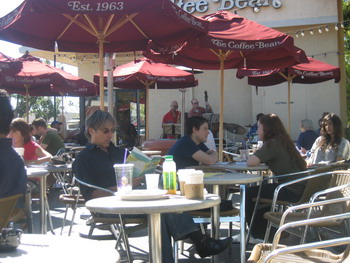
82 F. Wander over to the cafe. Have some tea, coffee. The band plays “Caravan.”
Spring in Los Angeles. Life is good.
Sunday is always a good day for grocery shopping. On the list today was some stuff from Trader Joe’s and from Whole Foods. I love Trader Joe’s. The stores are cheerful places, both for shopping and for meeting people. I also like the philosophy of providing the average Joe and Joette with products a bit off the beaten track at very reasonable prices with an increasing emphasis on organic food. The true deciding factor – how can I not love shopping somewhere with palm trees in front of the door?

With Whole Foods I have a bit of a problem. Every time I step inside one of these places I have a flashback to John Brunner’s “The Sheep Look Up”. Those who know the book know what I mean; those who don’t should go out and get a copy. One of the things Mr. Brunner describes in his book is the chasm which (in the near future seen from the viewpoint of 1972) has emerged to separate the rich, healthy, and privileged from the poor, sick, and oppressed. Seen against that background the Whole Foods philosophy of providing everybody who has a lot of money to spend with food mostly uncontaminated is a bit – well, let’s put it like that – the near future is the present already.
So, why do I not stay away from their stores? They carry my favorite toothpaste and cheese. What can one do?
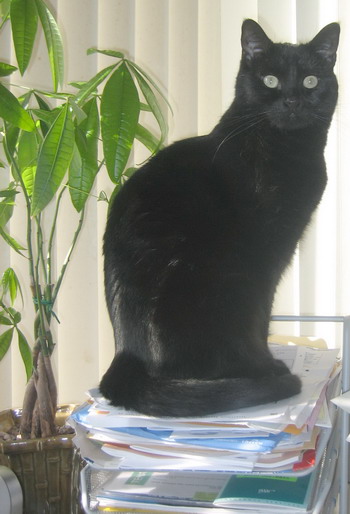
I’ve had strange things in my inbox before, but this is rather…
Where to file?
B = Black humor
C = Cat
D = Don’t really know (aka “file 13”)
Most importantly, will the cat stay in the filing cabinet? Somehow I doubt it.
Last night was the night of the lunar eclipse.

Even though it looked as if a cloud cover would obstruct the view, in the end the sky was clear enough to watch the moon wander through the Earth’s shadow, disappear and appear again.
Watching this I was reminded of the total solar eclipse in August 1999. At that time I was at the University of Cambridge in the UK and lectures stopped for all of us to go outside and watch this rather rare “special performance.”
What struck me most was not so much the drop in light level – that was to be expected and was quite remarkable, even somewhat eerie. It did not get really pitch dark, but noticeably grey (for lack of a better word) and it felt as if temperatures had dropped quite a bit. The totally unexpected thing was that at one point the birds stopped singing. Apparently, for them, the drop in light level and temperature was the usual signal to stop their racket and settle in for the night. Which they did, at least for a short while. Once the eclipse was over, the usual chattering and singing was heard again. Maybe some of the birds even complained: “What’s up? Short night, blimey.”
Much more complaining certainly went on down in Devon and Cornwall. Those who had traveled down there to watch this rare event were disappointed twice: weather conditions were not good and getting back was near to impossible, as all major roads were gridlocked with rather miffed eclipse watchers.
I assume the twittering down there was rather more graphic than that of the birds on the lecture site in Cambridge.